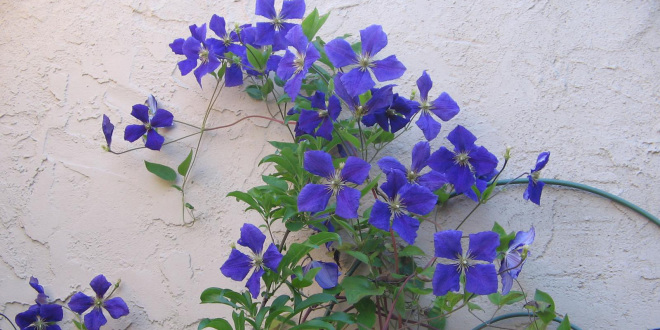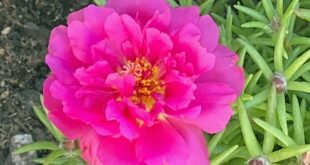A clematis vine climbing up a trellis or spilling flowers over a fence is great for making a curtain of color. Most clematis varieties thrive in U.S. Department of Agriculture plant hardiness zones 4 through 11 (which is just fine for our Sunnyvale garden (zone 8a)). Proper soil preparation, ongoing maintenance, pest prevention and pruning properly provide the keys to success with clematis. The plant comes in three varieties that flower at different times: type-A clematis blooms in spring, type-B flowers in summer, and type-C flowers in summer and fall but dies back in winter.
The following are detailed and excellent advice. But here is my story: One of the only open spots I had for planting vines was in a 4 inch-wide trench between a stucco wall and pool coping, in the shade of a 15 foot tall cherry tree. I bought the smallest pot (1 gallon) of clematis. Then gently loosened the dirt on the clematis to make it 4 inches wide, 6 inches long and 6 inches deep. I dug the hole; soaked the soil with water and liquid fertilizer; and planted. That vine has reliably flowered in summer and fall for ten years.
Adjust the PH. Perform a soil pH test on the planting site to determine the pH, which must fall between 7.0 and 7.5 for successful clematis growing. Add sulfur to the soil to lower the pH or agricultural limestone to raise the pH, using the amount specified by the soil test. Mix the sulfur or lime in the top 10 to 12 inches of soil at least once month before planting.
Dig the hole. Dig a 12-inch-deep planting hole that’s twice as wide as the nursery container. Mix the removed soil with an equal amount of compost.
Plant the vine. Lift the clematis from the container and set it in the hole. Adjust the depth of the soil beneath the clematis roots so the plant is sitting at the same depth it was growing at previously. Fill in the hole with the mixed soil and water thoroughly until it’s evenly moist to the depth of the root ball. Space plants two to three feet apart.
Mulch: Spread 3 inches of mulch over the planting bed but leave a 2-inch space between the mulch and the clematis stem. Mulch retains moisture and prevents weed competition that could stress the clematis vine.
Watering: Water clematis approximately once a week and provide about 1 inch of water each time. The top 8 to 10 inches of soil should remain evenly moist, but avoid soggy or waterlogged conditions. Water evenly to lead to more successful blooming and vine growth. Diseases and pests are also more likely to affect water-stressed plants. Water more frequently if your soil dries quickly.
Fertilizing: Apply a balanced fertilizer, such as a 10-10-10 blend, at the rate recommended on the label for your planting bed size. Fertilize clematis in spring when new growth begins. Sprinkle the fertilizer on top the soil, about six inches away from the base of the plant, and water immediately after application. Annual fertilization ensures continued healthy growth, but over-fertilization can result in lush foliage but few blooms.
Pruning: Trim type-A varieties after they bloom in spring and only remove the tips of the vines or cut out dead vines. Prune type-B using the same method after they finish flowering, but you can thin out some vines to allow air circulation. Cut back type-C clematis to within 1 foot of the ground in late winter after it dies back. Pruning at the wrong time for the clematis variety can cut off productive wood, resulting in poor flowering the following year. Cut out any vines that rapidly wilt as soon as you notice them. Trim back the affected vine to the nearest healthy wood. Sanitize the pruning shears in a solution of 1 part bleach and 9 parts water to avoid spreading disease. Clematis wilt can kill the entire plant if the affected portion isn’t removed promptly.
Insect care: Inspect the foliage and flowers weekly for mildew or insect pests. Aphids and other common pests often feed on the undersides of the leaves. Avoid overhead watering, which leads to fungal problems. Spray insect pests with an insecticidal soap, following package application instructions.
Things You Will Need
Soil pH test kit
Sulfur or lime
Spade
Compost
Mulch
Balanced fertilizer
Pruning shears
Bleach
Insecticidal soap
Tips
Climbing clematis varieties require a sturdy support system, such as a trellis or fence. Choose a trellis with supports no more than 3/4 inch in diameter to ensure the vines can climb it successfully.
Select a clematis variety suitable for your site. Most varieties grow best with a full six to eight hours of daily sunlight. Plant a variety that tolerates some shade, such as “Hagley Hybrid,” if your site doesn’t receive full sun.














